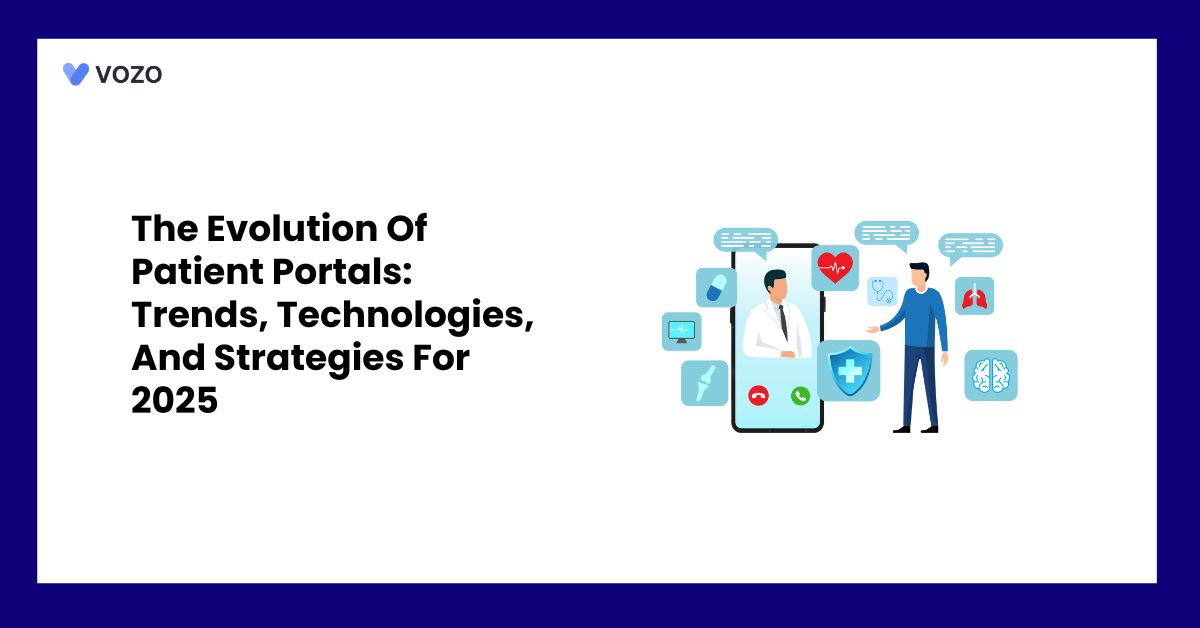The Evolution Of Patient Portals: Trends, Technologies, And Strategies For 2025
The patient portal is becoming a crucial tool for patient involvement, convenience, and treatment continuity as healthcare shifts to patient-centered approaches.
Portals will develop into interactive ecosystems in the next years that support value-based care initiatives, expedite clinical processes, and empower patients. In this blog, you’ll learn how the patient portal will transform future healthcare.
The Future Trends of Healthcare in 2025
1. AI-Driven Automation
AI is redefining patient interactions through personalized healthcare experiences. Machine learning algorithms assess patients’ medical history, social behaviors, and real-time biometric data to provide tailored treatment plans, such as a medication reminders portal.
AI-powered chatbots and virtual assistants handle routine queries, appointment booking, and triage automatically to reduce administrative burden and improve response times.
2. Mobile-First, Interoperable Design
70% of the interactions are held in mobile accounts, and mobile-first design plays an important role in the patient portal.
- Modern portals use responsive web frameworks or native apps to provide seamless experiences across all devices. As well as biometric login, such as fingerprint or face recognition, for added security and convenience.
- FHIR standards enable real interoperability, allowing portals to combine data from EHRs, telehealth platforms, and wearable devices, offering patients a single perspective of their health journey.
3. Enhanced Security and Regulatory Compliance
Portals grow in functionality and data volume, with strong security and privacy standards becoming critical.
- Patient data is protected with advanced encryption, MFA, and real-time threat monitoring.
- Consent management modules allow users to select who can access health information.
- Privacy requirements like HIPAA and GDPR will require portals to provide audit trails and automatic breach alerts, promoting confidence and legal compliance.
4. Self-Service Tools for Patients
- By facilitating online appointments and pre-visit registration, online scheduling enables patients to avoid phone lines and no-shows.
- By ensuring prompt communication between patients and providers, HIPAA compliance helps to cut down on pointless office visits.
- Financial transactions are streamlined by integrated insurance verification, payment plans, and e-billing.
Related: Top 10 Features to Consider Before Choosing the Patient Portal
5. Integrating RPM and CCM
- Integration with wearable devices such as glucose monitors, blood pressure cuffs will feed the data directly into the patient dashboards. If the vital signs are out of range, it sends alerts to the care team for early interventions.
- Educational modules and virtual coaching programs are embedded in the portal support, which helps in driving long-term outcomes and reducing readmissions.
6. Data Analytics for Value-Based Care
- Portals with robust analytics help to monitor KPIs, readmission rates, preventative screening, and chronic disease metrics on a patient and population basis.
- Interactive dashboards support care managers in identifying high-risk populations, classifying interventions, and monitoring results, allowing health systems to succeed under value-based reimbursement models.
Emerging Trends in Healthcare
- Voice and conversational interfaces improve accessibility for visually impaired and mobility-challenged users.
- Blockchain technology allows for safe, consent-driven record exchange across institutional borders, resulting in patient-owned data wallets that cannot be changed.
- Advanced wearables and digital therapeutics have implantable sensors, ingestible tablets that will provide richer data streams to portals, enabling hyper-personalized therapies.
Strategies to Optimize Your Portal in 2025
- Conduct iterative usability testing with a variety of patient demographics. Prioritize clear microcopy, simple navigation, and user-friendly design.
- Provide comprehensive onboarding and education, including guided tours, FAQs, and multilingual help, to increase adoption and minimize support calls.
- Monitor portal KPIs that include login frequency, message response time, feature uptake, and iterate quickly based on analytics.
- Partner with suppliers who follow open standards like FHIR, OAuth 2,0, and interface smoothly with your EHR, RPM, telehealth, and billing systems.
- Stay ahead of changing privacy and security standards with automatic compliance audits, policy changes, and frequent staff training.
Related: The Ultimate Guide To Patient Portal Software In 2025
Vozo Patient Portal Solution
Vozo patient portal software provides a comprehensive solution to help healthcare providers achieve clinical, financial, and operational excellence through a powerful patient portal.
Our exceptional Patient Portal Software will allow:
- Have complete access to patients’ medical records digitally
- Our cost-effective subscription plan helps healthcare practices at all levels.
- The Vozo patient portal can effortlessly be integrated and implemented with any EHR system to increase productivity.
- Vozo’s Patient Portal respects users’ privacy and safeguards health-related records and personal information.
- 24/7 availability to support you with your needs and requirements.
- By understanding your unique needs for your specialty healthcare practice, we will customize Vozo’s patient portal for a seamless workflow.
Patients can request appointments, access health records and lab results, and even pay bills online with the help of a patient portal, which creates a personal touch with you always.
Leverage the Vozo Patient Portal for Better Healthcare Solutions.
About the author

With more than 4 years of experience in the dynamic healthcare technology landscape, Sid specializes in crafting compelling content on topics including EHR/EMR, patient portals, healthcare automation, remote patient monitoring, and health information exchange. His expertise lies in translating cutting-edge innovations and intricate topics into engaging narratives that resonate with diverse audiences.













